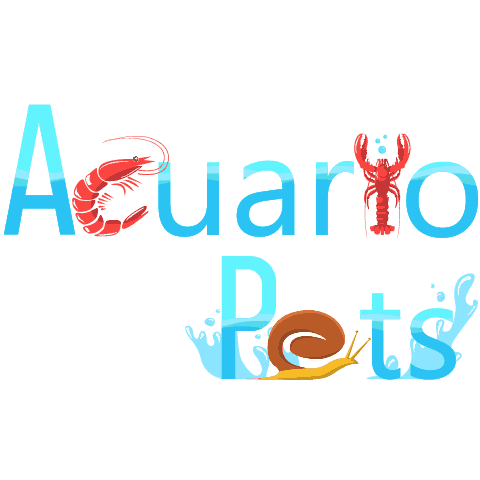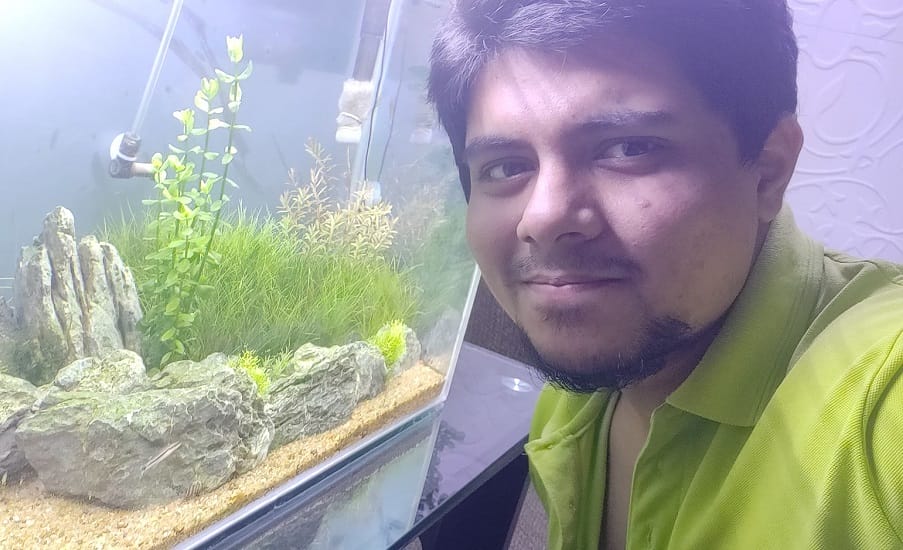How To Take Care Of Desert Rain Frog? [With Interesting Facts]
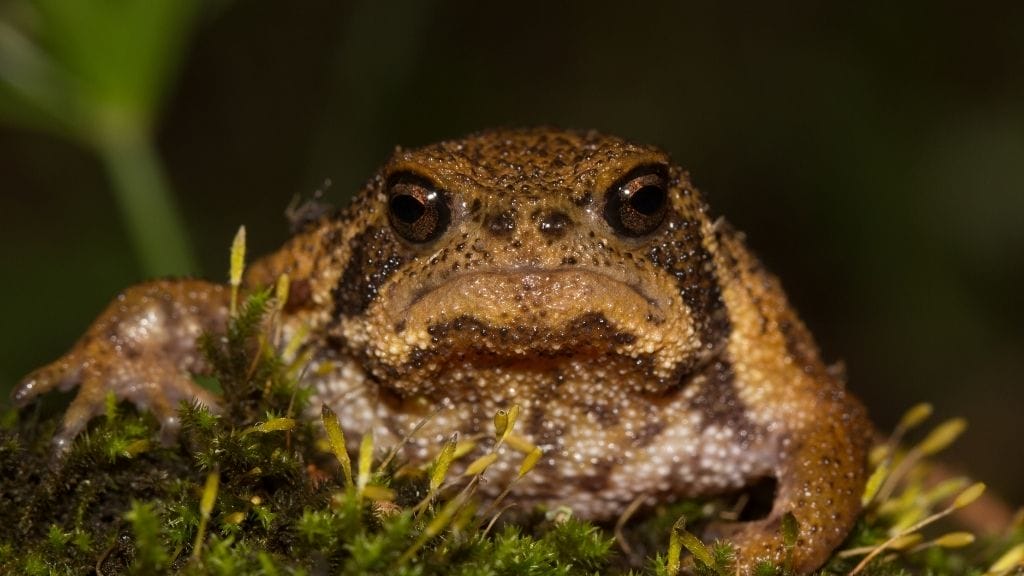
These potato resembling cute desert rain frogs have become one of the most top-wanted frogs for pet lovers. As desert rain frogs have lesser fame than other frogs, many people do not know how to take care of desert rain frogs. Knowing the required conditions of keeping a desert rain frog will help you get a long-time accompany of your pet frog in captivity.
Hence, I’ve researched a while to know the details of desert rain frog care and maintenance.
In this article, I have summed up all information about their habitat setup, environmental conditions, feeding, and reproduction care, etc.
In short, you will get a crystal clear guide on how to take care of desert rain frogs. So, I will urge you not to miss this article if you want to get enlightened more.
Can I Keep A Desert Rain Frog As A Pet?
Considering the basic needs and conditions of maintenance, the frog lovers decide to keep any frog as a pet. In the case of desert rain frogs, many pet lovers remain confused about keeping these frogs.
You can keep a desert rain frog as a pet. These frogs are easy to care for and have fewer maintenance conditions. Besides, there is no hassle in maintaining their feeding guide. But, you need to ensure maintaining their special requirements of habitats. Moreover, these frogs are not toxic at all.
However, you should not expect any quick emotional attachment from desert rain frogs. But, you might notice more calmness or quick response while feeding day by day.
These desert rain frogs require some time to associate with the owners. Usually, baby desert rain frogs are more convenient to keep as pets.
Every pet has its own distinct needs. If you can fulfill those needs, you will easily keep any frogs as pets. So, desert rain frogs are not exceptions.
Want to get a printable version of this infographic? Click here! [If you want to use this infographic on your website, please link back to this post as the source!]
Desert Rain Frog Overview
For your convenience, I have gathered up some basic information about desert rain frogs. The following chart has an overview of desert rain frogs. Let’s check this out.
| Scientific Name | Breviceps macrops |
| Common Name | Desert Rain Frog, or web-footed rain frog, or Boulenger’s short-headed frog |
| Appearance | Small frogs with bulging eyes, short snout, short limbs, and webbed toes. |
| Size | 1.6-2.5 inches (4-6 cm) |
| Toxicity Status | Non-toxic |
| Temperament | Active, playful, and peaceful |
| Diet | Insectivores |
| Care Level | Easy |
| Lifespan | 4-15 years |
Desert Rain Frog Size
Before buying a terrarium for your desert rain frog, you should consider the size and number of desert rain frogs that you want to keep in the tank. These frogs do not get too big. The average size of desert rain frogs is 1.4-2.6 inches.
How Long Do Desert Rain Frogs Live?
The lifespan of desert rain frogs varies on several factors. In the wild, the average lifespan of these frogs may get shorter due to a lack of food, predators, natural calamities, etc.
Generally, desert rain frogs can live for a long time burrowing themselves in sandy dunes. These frogs do not rely upon water sources. So, their lifespan doesn’t have any effects due to the unavailability of water.
The average lifespan of desert rain frogs is between 4-6 years. However, these rain frogs can live up to 15 years. If you provide their basic requirements and proper care, your desert rain frogs may survive 5 to 10 years in captivity.
How Much Is A Desert Rain Frog?
The cost of a desert rain frog may vary from store to store. You may also notice the differences in the price of these cute frogs from local stores to online stores. Besides, the cost of desert rain frogs depends on the age of these frogs too.
The average cost of desert rain frog ranges from $39.99 to $105. If you buy rain frogs from online stores, you should expect to pay the delivery charge too.
How Do You Take Care Of A Desert Rain Frog?
Taking care of your frog means maintenance in a vast array including its housing, feeding, and so on. For this, you need to know about the nature of desert rain frogs. After all, you have to mimic the wild environment of their habitat in captivity. Otherwise, your pet rain frog will not survive.
Let’s start with the care guide of housing setup of desert rain frog at first.
Housing Your Desert Rain Frog
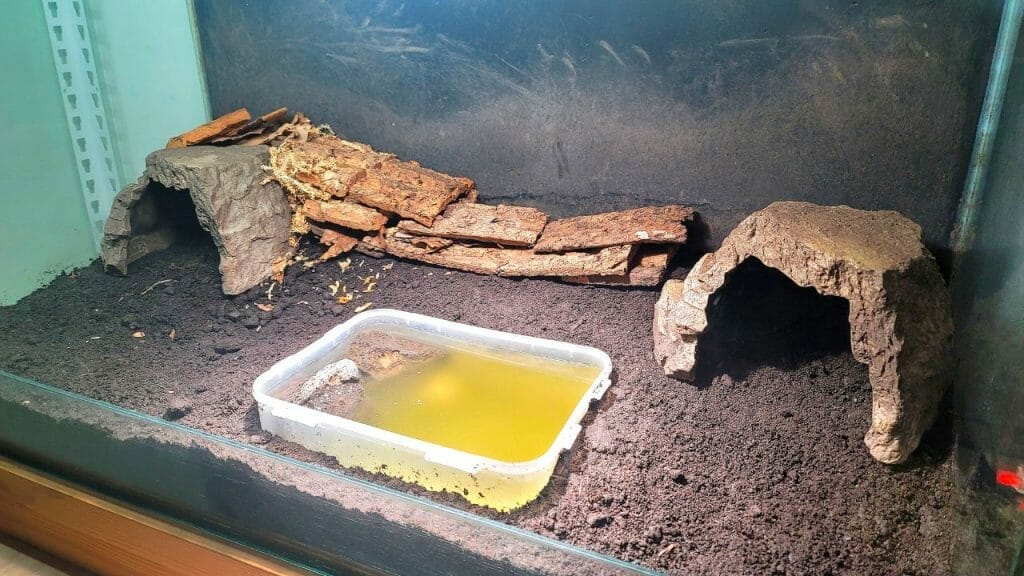
Selecting Right Tank Size: How Big Of a Tank Does A Rain Frog Need?
When you decide to set up the habitat of your desert rain frog, you should consider a few things. These depending factors are-
- The size of your rain frog
- Tank type
- Playfulness
- Placing the tank in a suitable place
So, before choosing the right tank, you must know the required tank type and its size. It is an essential part of ensuring the best care of desert rain frogs.
You might have known that there are huge differences between aquatic and terrestrial tanks. The desert rain frogs are terrestrial. Thus, you can choose a terrestrial tank for your rain frog.
The desert rain frogs are pretty smaller in size. The average size of adult desert rain frogs is between 1.6-2.5 inches. So, their size may fool you into choosing a tank of small size. But, do not get fooled by their size.
On the other hand, these frogs are active and playful. So, they require a large space to move and play in the tank.
Considering all of these facts, you can buy a terrestrial tank of 5-10 gallons for your desert rain frog.
Since these desert frogs are not climbers, they need enough space to roam around. So, you should buy such a tank which has enough horizontal space.
I recommend you this 10 gallon tank from Aqueon for desert rain frogs. This tank has a large space in the horizontal areas.
Filling The Tank Bottom With Right Substrate
In the list of desert rain frog care, choosing the right substrate remains at the top of habitat setup conditions. In the wild, desert rain frogs live in a sandy habitat.
These frogs remain burrowed under the sands for the entire day. Usually, the rain frogs dig the sands with their short legs. Also, they can go deep under 10-20 cm.
These frogs absorb their required moisture from the sands. Hence, you need to mimic this condition with the correct substrate.
You should choose such substrate for your desert rain frogs that will hold the maximum moisture. These substrate options can be coconut husks, cypress mulch, soils, reptile barks, orchid barks, sphagnum moss, and so on. You can also mix them up.
Before setting up the substrate, you should pour dechlorinated water into the tank. After this, you have to let the substrate soak the water.
Make sure that the substrate becomes deep around 25 cm. That is because the rain frogs love to dig the substrate deeper than other frogs.
If you are looking for substrate, eco earth will be the best option for desert rain frogs.
Although one pack of this substrate covers the entire bottom of the tank, you can add another package to make its density deep. It will provide a naturalistic environment to your desert rain frog.
Need To Talk With A Vet Right Now?
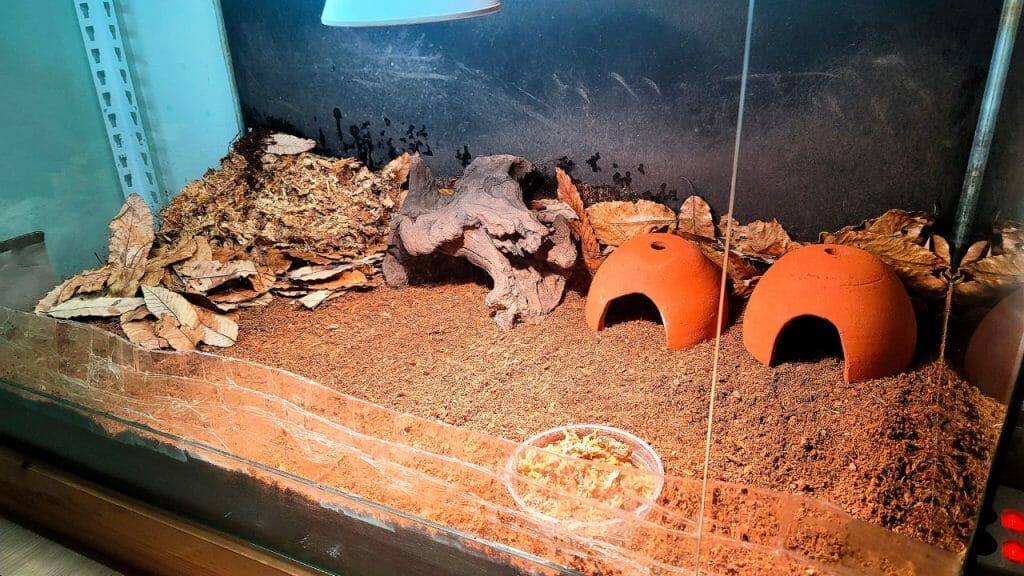
Environmental Conditions For Desert Rain Frogs
To take the best care of your desert rain frogs, you should know their environmental conditions. You must ensure the same environmental conditions in captivity.
In the wild, desert rain frogs hail from sandy areas where the environment remains humid. Besides, their natural habitat remains foggy because of the presence of nearby water sources.
Hence, you must keep the rain frog tank humid. So, the humidity level should be around 75%-100%. On the other hand, the temperature should be around 30 degrees Celsius. It will create a foggy environment in the tank.
No wonder you must take care of the tank conditions to keep your desert rain frog happy. You should spray the rain frog tank twice daily. Also, do not mist the substrate, the tank walls, another décor, etc.
Besides, you can keep water which will assist in maintaining the optimal humidity level. Moreover, to check the humidity and temperature, you should keep the necessary types of equipment.
What Else Needs To Be In A Tank Of A Desert Rain Frog?
Desert rain frogs do not require many things in their tank. Because of being nocturnal animals, desert rain frogs come out of the substrate at night. However, you should keep the décor items and the tank as simple as possible.
As desert rain frogs are pretty playful, you can keep décor items in the tank. Do not forget to add barks, branches, hideouts, rocks, fake or live plants, and so on. Make sure that your pet frog will not get injured by the sharp edges of décor items.
For the safety of your frog, you should choose lightweight décor items. Moreover, you should keep a water dish with fresh water. Besides, you can keep a water sprayer. Also, a thermometer and a humidifier are some must-to-keep things.
Besides, you might have known that these frogs are not great jumpers. The desert rain frogs can only hop or run with their webbed foot. So, there are no risks of jumping out of the tank.
Hence, there is not any restriction on adding a tank lid. But, you can keep a tank lid over the tank for your frog’s safety.
Feeding Care And Guide: What Do You Feed Rain Frogs?
The diet of desert rain frogs is pretty simple. The desert rain frogs are completely insectivores. So, their diet will be based upon only insects.
I have made a list of insects that you can feed your desert rain frogs. These are-
- Beetles
- Crickets
- Dubia roaches
- Slugs
- Locusts
- Grasshoppers
- Gnats
- Dragonflies
- Termites
- Moths
- Various larvae
- Waxworms
- Bloodworms
- Small vertebrates
You should make sure that the insects are smaller in size than your rain frogs. Otherwise, your rain frog will struggle to digest the large insects.
Reproduction Phase Care
Since desert rain frogs are nocturnal frogs, they start their mating cycle after dark. So, you should create a mating-friendly environment in the rain frog tank. Besides, the female rain frogs burrow themselves after mating and lay anywhere around 12-40 eggs at a time.
Usually, frogs tend to breed in open water areas. But, desert rain frogs do not need water sources to breed. However, you should ensure high humidity in the tank.
On the other hand, make sure that the female rain frogs can burrow the substrate comfortably after mating. Besides, you should try to avoid any disturbance around their tank during their mating period.
Another interesting fact about desert rain frogs is that they do not have any tadpole stage like other frogs. These frogs turn into froglets directly from the eggs.
Moreover, these newly borne desert rain frogs remain self-sufficient. They can eat, burrow, or play on their own. So, you do not need to take extra care of these baby rain frogs.
Set the baby frogs in the appropriate habitat and take care of their feeding amount. The baby desert rain frogs usually tend to eat much more than the adult rain frogs.
Hence, you can start feeding insects twice a day. But, make sure that the insects are not large enough to make them choke.
Where Can I Buy A Desert Rain Frog?
In case you don’t know yet, desert rain frogs are enlisted among the endangered animals. So, it’s almost impossible to find desert rain frogs in the pet trade.
If you live in South Africa, you may buy these desert rain frogs from local frog breeders. These breeders collect wild-caught desert rain frogs. Since these rain frogs are only available in South Africa and Namibia, you may not find these frogs in other regions.
However, I’ve found a few online stores from where you can buy a desert rain frog. In the case of Backwater reptiles, the cost of an adult desert rain frog is $49.99. if you buy a desert rain frog from Underground Reptiles, the price will start from $39.99.
You can also find these rain frogs in the online stores of Strictly Reptiles, All Reptiles, Petco, etc.
Are desert rain frogs good pets?
While desert rain frogs may appear cute and interesting, they are not typically kept as pets for several reasons such as specialized habitat requirement and limited availability,
Where is the desert rain frog’s natural habitat?
The desert rain frog, also known as Breviceps macrops, is native to the southwestern coastal regions of Namibia and South Africa. Specifically, it inhabits the Namib Desert, which stretches along the Atlantic coast of Namibia, and the Namaqualand region in South Africa.
What do common rain frogs eat?
Common rain frogs, belonging to the family Brevicipitidae, have a varied diet consisting primarily of insects and other small invertebrates. They feed on a range of prey, including ants, beetles, spiders, crickets, termites, small flies, worms, snails, slugs, and other soft-bodied invertebrates.
Are desert rain frogs noisy?
Yes, desert rain frogs are known for their distinctive and surprisingly loud vocalizations. Despite their small size, these frogs produce a unique and somewhat comical sound that has earned them the nickname “squeaky toy” frogs.
How fast is a desert rain frog?
Desert rain frogs are not known for their speed or agility. They have a stocky, round body shape and short limbs, which are not adapted for rapid movement. Their primary mode of locomotion is by crawling and hopping rather than running.
Final Words
After going through this article, you must have realized that desert rain frogs are pretty easy to care for and maintain. They are happy with a few fundamental conditions and needs. If you take care of this cute frog properly, this frog will accompany you for up to 15 years.
About Author
Hello, I’m Muntaseer Rahman, the owner of AcuarioPets.com. I’m passionate about aquarium pets like shrimps, snails, crabs, and crayfish. I’ve created this website to share my expertise and help you provide better care for these amazing pets.
Disclaimer
This site is owned and operated by Muntaseer Rahman. AcuarioPets.com is a participant in the Amazon Services LLC Associates Program, an affiliate advertising program designed to provide a means for sites to earn advertising fees by advertising and linking to Amazon.com. This site also participates in other affiliate programs and is compensated for referring traffic and business to these companies.
